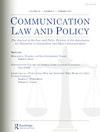国际人权法中的新闻自由
IF 0.2
Q4 LAW
引用次数: 2
摘要
当代各种类型的攻击促使人们呼吁加强公众对新闻业的支持和法律保护。在世界各地,新闻业不仅面临影响编辑内容的政府监管,还面临经济和企业压力,以及公众对其社会功能缺乏了解。在美国,法院甚至新闻机构一直不愿定义新闻业,也不愿将其单独列为特殊保护对象。但国际人权法提供了一个可能的解决方案。本文讨论了保护从事新闻工作的个人的国际人权法条款。联合国人权事务委员会为在更大的言论自由国际法框架内界定和保护新闻业的独特职能奠定了基础。这一基础包括将个人新闻权利与机构媒体或新闻权利区分开来的可能性。文章认为,这种区别已经变得越来越重要。国际法相称性测试可以解决人们对将新闻业定义为一项独立基本权利的担忧。本文章由计算机程序翻译,如有差异,请以英文原文为准。
Freedom of Journalism in International Human Rights Law
Contemporary attacks of various types have prompted calls for stronger public support and legal protections for journalism. Around the world, journalism faces not only government regulation that affects editorial content but also economic and corporate pressures as well as lack of public understanding of its societal functions. In the United States, courts and even journalism organizations have been reluctant to define journalism or single it out for special protection. But international human rights law presents a possible solution. This article discusses the international human rights law provisions that protect individuals engaged in journalism. The United Nations Human Rights Committee has laid groundwork to define and protect journalism’s unique functions within the larger international law framework for freedom of expression. This groundwork includes the possibility for individual journalism rights to be distinguished from institutional media or press rights. The article contends that such a distinction has become increasingly important. The international law proportionality test could resolve concerns about defining journalism as a stand-alone fundamental right.
求助全文
通过发布文献求助,成功后即可免费获取论文全文。
去求助
来源期刊
CiteScore
0.60
自引率
33.30%
发文量
7
期刊介绍:
The societal, cultural, economic and political dimensions of communication, including the freedoms of speech and press, are undergoing dramatic global changes. The convergence of the mass media, telecommunications, and computers has raised important questions reflected in analyses of modern communication law, policy, and regulation. Serving as a forum for discussions of these continuing and emerging questions, Communication Law and Policy considers traditional and contemporary problems of freedom of expression and dissemination, including theoretical, conceptual and methodological issues inherent in the special conditions presented by new media and information technologies.

 求助内容:
求助内容: 应助结果提醒方式:
应助结果提醒方式:


